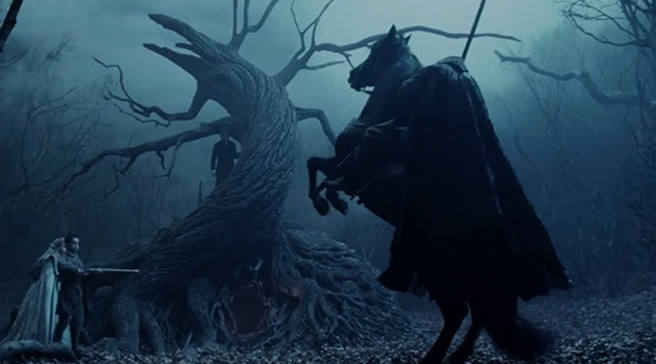
Tim Burton’s unique brand of “Pop Goth” has become so codified and commodified in popular culture that his films seem to exist as an entity beyond film. The cult following, that numbers in the millions, devoted to this brand has become such a force in the mainstream that it practically constitutes its own sub-culture. To dislike or criticize a film or show by Tim Burton is taken as an attack on that sub-culture by its members. This has been going on for so long that it is difficult to determine when, in the popular mind, Burton went from being a filmmaking to being a mass marketed style.
This phenomenon places Tim Burton alongside filmmakers like George Lucas and Christopher Nolan who perpetuate cultural currents more effectively than they make films. Lucas, Burton and Nolan all preside over their own little fiefdom on the cultural landscape. Each was once heralded as part of a new vanguard in cinematic art, and each became little more than a mass marketable collection of products.
Arguably Tim Burton’s metamorphosis from auteur to brand occurred shortly after the controversial Batman Returns (1992) with the release of A Nightmare Before Christmas (1993) and Mars Attacks! (1996). By the time Tim Burton made Sleepy Hollow (1999) his trademark two-tone Gothic style had permeated America’s mall culture and set him up as the filmmaker for angsty, artsy adolescents. Sleepy Hollow sees this style in overdrive, running roughshod over the source material in a fashion that had been denied to Burton when working with established properties like Batman.
What makes a film like Batman Returns so great is the way that an auteur (Burton) comes into conflict with studio mandates (Warner Bros.) and attempts to resolve them. The give and take between art and the restrictions of a well guarded intellectual property make for more unique commercial films that often re-write a genre or, in the case of Batman Returns, sets a franchise into a tail spin. Sleepy Hollow came without the ordinances or guidelines that stalk Batman projects which allowed Burton to indulge himself as much as he wanted.
The resulting film loosely inspired by Washington Irving’s story is a hodgepodge of Tim Burton’s dearest preoccupations, fetishes, and trademarks. Sleepy Hollow is a blood soaked Harold Lloyd comedy as much as it is an homage to Hammer Horror films and old Disney cel animations. These disparate whims and fancies fly apart as the film races to its conclusion, barely kept together by Burton’s astounding production design.
Sleepy Hollow is a mystery in the same vein as season one of Wednesday (2022) in that both films inject the narrative formula of the mystery into a pre-existing narrative world. Neither creation prioritizes the mystery itself or the characters tasked with solving it. Instead, Sleepy Hollow and Wednesday offer little more than unadulterated, highly marketable Tim Burton spectacles.
But these are such sweet, immersive spectacles indeed. Sleepy Hollow, like Pumpkinhead (1988), fabricates a uniquely American world of folklore and nightmares that barrows its aesthetic stratagems from such diverse sources as Powell & Pressburger, F.W. Murnau, and the paintings of Andrew Wyeth. Sleepy Hollow is never convincing with regards to characters or plots, but it does sell a wholly unique world born of post-modernist intertextuality.
Evocative, immersive, and stylish are all accurate descriptors of Sleepy Hollow and Burton’s style in general. Yet, it is little more than style for style’s sake. Burton’s films have nothing to say about the medium really and even less to say or observe about people, politics or poetry. Sleepy Hollow is little more than a children’s television special that has been over dressed and rendered with copious amounts of gore. Batman Returns is Tim Burton’s best film but Sleepy Hollow is his most Tim Burton film.
